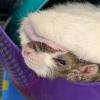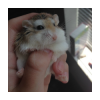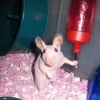This thread is part of a multi-thread series on hamster nutrition. Originally Parts I, II, III, and IV were originally written as one thread, but were split due to length. For this reason, the guide works best if the threads are read in their numbered order. However this is not strictly necessary, as each thread can stand on its own as well.
Below, you will see a listing of the different threads in the series and links to them:
[HAMSTER NUTRITION I] Nutrition, Variety, and Quality
[HAMSTER NUTRITION II] Food Mixing
[HAMSTER NUTRITION III] Calculating the Guaranteed Analysis of a Mixed Diet
[HAMSTER NUTRITION IV] Commercial Food List
[HAMSTER NUTRITION V] Safe and Unsafe Foods for Hamsters
Credits - Sincere thanks to Christmas_hamster, the creator of the original Master Food List which inspired this project. Next, nebit had an enormous role in developing, editing, and improving these threads. Finally, HoppingHammy and tbiM20 also offered tons of editing, advice, and contributions. Thank you all for your help--this wouldn't have been possible without you!
WHAT MAKES A "GOOD" HAMSTER DIET?
On this forum in the past, the answer to this question was very simple - nutrition. That is, the amount of protein, fat, and fiber in the food. If hamster food had exactly the right amount of protein, fat, and fiber, it was automatically considered a good food. If it did not, it was automatically considered a bad food.
However, this is an overly simplistic way to think about diet. While nutrition is extremely important, there are other factors worth considering. A food can have good nutrition but use terrible-quality ingredients. And hamsters, being foragers, need variety in their diets as well.
As such, we currently look at 3 main factors to evaluate a hamster food:
Nutrition – The overall levels of protein, fat, and fiber in the food
Variety – The number of whole ingredients and their abundance in the food
Quality – The uniqueness, nutrition, and safety of individual ingredients
NUTRITION
The very first thing you should look at in a hamster food is its nutritional profile, also known as the Guaranteed Analysis. This is the label that will tell you how much fat, protein, and fiber are in the food.
Below are Hamster Hideout's recommendations:
Protein - 17% - 19% for most adults, 20% - 24% for growing animals under 6 months
There is no one set percentage of protein that is right for every hamster and every situation. Protein needs can vary by age, species, and individual. For example, some elderly hamsters (2+ years) may need less protein, though this is not the case for all, or even most, animals. Younger hamsters (up to ~1 year) will often need higher levels of protein for growth and development. Hamsters in poor health from certain diseases may need more protein for energy and recovery. Other diseases—like kidney disease, for example—require lower protein levels. Anecdotally, Roborovski’s dwarf hamsters are assumed to need more protein, due to their extremely high activity level and metabolism.
It is useful to think of protein as a range, rather than a single number. There is no “one size fits all” protein percentage. However, what this also means is that not every protein level in the given range is going to be appropriate for a single hamster. For example, 15% protein may be fine for a very elderly hamster, but it is in no way appropriate for a growing pup or even a healthy adult. Conversely, 24% protein is great for a young pup, but probably not necessary (and even potentially harmful) to an elderly hamster.
The extreme ends of the range are applicable to very specific situations. At most health levels and life stages, protein should be between 17% and 19%.
Fat - 4% - 7%
Fat is typically not a problem, but there are foods that have either too little or too much fat. While too much fat is an obvious problem, too little fat can be just as bad. Fat is needed in proper levels for energy and various biological functions. Different animals may need different levels of fat. One hamster may have weight gain issues on a diet of 7% fat, while another hamster may do just fine on it.
Fiber - 6% - 15%
Fiber is essential for proper digestion. It's actually thought that low-fiber diets can contribute to stomach issues, because fiber is needed to nourish the beneficial bacteria found in the hamster’s gut. It's pretty rare to find a hamster food that has too much fiber--too-low fiber is a much bigger concern.
Below are sources and citations for these recommendations. More details (especially about protein in particular) can be found here – On the Topic of Protein and Age
VARIETY
Hamsters need variety in their diets, and thrive on foods with different tastes and textures. A hamster's diet must include more than just pellets! While pellets are a very important and beneficial part of a hamster’s diet, they should not be the only source of nutrition.
Simply put, variety is a measure of how many different whole ingredients are in a food in comparison to the pellets. First, let's pause a moment to define what whole ingredients and pellets are:
Whole ingredients are items in a mix—seeds, nuts, fruits, vegetables, and insects—that have been minimally processed or are provided in their natural form. Basically, anything that's not a pellet is a whole ingredient.
Pellets are human-manufactured pieces of food. They are made by grinding up various ingredients and extruding them into uniform shapes. It's very similar to how dog food or human breakfast cereals are made. Pellets can come in many different shapes and textures, and can also be called biscuits or kibble.
There are two different measures of variety that should be considered:
Raw Variety
This is a simple count of the number of unique whole foods found on the ingredient list. For example, look at the ingredients list for Hazel Hamster food (excluding vitamins and minerals):
Ground wheat, toasted wheat, flaked peas, soybean meal, whole corn, flaked whole corn, sunflower seeds, flaked soybeans, dehydrated alfalfa meal, peanut kernels, soybean oil, peanuts in shells, pumpkin seeds, soybean hulls, wheat middlings, extruded locust beans...
The whole ingredients are underlined. This food has 8 whole ingredients, so it would have a variety score of 8.
One problem when counting ingredients is ingredient splitting. Ingredient splitting is when several different forms of the same ingredient are treated as completely separate ingredients and listed individually. For example, you'll notice that Hazel Hamster has whole corn, and then flaked whole corn listed right after it. These ingredients are the same exact thing - corn. It's just that the flaked corn is smashed flat. For this reason, the flaked corn is not counted as a separate ingredient (is not underlined). The same is true with the peanut kernels and peanuts in shells.
Ingredient splitting can make it seem like a food has more variety than it actually does, because more ingredients will be listed. It can also be used to disguise the true amount of less desirable ingredients. Splitting allows an undesirable ingredient to be listed lower on the ingredient list.
True Variety
The number of whole ingredients in a mix only tells part of the story. Ingredient lists tell us what whole ingredients are present in the mix, but they do not tell us the amount of each ingredient in the mix.
To assess true variety, we have to consider 2 points:
1) How many whole ingredients are there in relation to the pellets?
Consider the following image:

Carefresh Complete Menu is an example of a food with poor true variety. Note that the sample pictured is almost all pellets. There are a few seeds and a couple of peas, but the pellets are the overwhelming majority of the food.
VitaKraft VitaNature is an example of a food with good true variety. The sample pictured has a wide variety of whole ingredients. Even in that small sample, there are at least 6 or 7 different types of seeds and legumes represented.
2) Are the whole ingredients found in significant quantities?
Just because a whole ingredient is listed does not mean that it is found in significant quantities. To use an extreme example, a manufacturer can add 1 flaxseed to a 2lb bag and list flaxseed as an ingredient. But realistically, how much of a difference is that single flaxseed making in the diet? Basically none.
Note the ingredients list for Bunny Dwarf Hamster Dream:
Oats, barley, millet, canary seed, pea flakes, corn, wheat bran, oats, barley flakes, sunflower seed meal, silver millet, rice, wheat, alfalfa, carrots, chicken meat, red millet, grass seeds, parsnips, dandelion, calcium carbonate, yarrow, plantain, spent grains, sesame, chamomile flowers, linseeds, carrot residues, beets, brewer's yeast, herring meal, animal fat, inulin, marigold flowers, mealworms (0.3%), chicken liver extract, dried, carob, salmon oil, linseed oil, lecithin, rose petals.
This food appears to have amazing variety, because there are many whole ingredients. However, note the ingredient bolded in red - calcium carbonate. This is a mineral additive that is used in very, very small quantities.
The problem with this food is that nearly half of the whole ingredients are listed after calcium carbonate in the ingredients list. What this means is that there are probably very, very few of these ingredients in the mix. While these ingredients still "count," we have to realize that this makes the variety much less than it at first appears to be.
QUALITY
Quality is a broad category with several different facets to consider.
Nutrition of Whole Ingredients
Having whole ingredients is important, of course. But we also have to consider the nutritional quality of the ingredients. Having lots of whole ingredients is meaningless if all of them are junk food. Are the ingredients nutritious, or are they just filler?
Let’s take a moment to talk about fillers, because they’re tricky to understand. A filler is an ingredient that does not offer much in the way of nutrition, vitamins, or minerals - it's basically just empty calories.
There's really only 1 filler ingredient that we need to be concerned about. That is the hard dent corn found in the vast majority of hamster mixes. Other than being a source of calories, corn provides almost no nutrition. It has very little protein, little fat, an average amount of fiber, and is fairly low in micronutrients (vitamins and minerals). Basically, it's just straight-up starch and carbohydrates. Given that a hamster's diet is largely carbohydrate-based already, corn is not unhealthy for them. However, it's still not the best-quality ingredient.
Part of the issue with fillers is selective feeding. Selective feeding is when a hamster only eats part of a mix, often because it prefers the taste of certain ingredients. If a hamster is selectively feeding on fillers, it’s not getting much nutrition. If it’s selectively feeding on non-filler ingredients, it’s at least getting some nutrition (albeit not balanced). Selective feeding can be a problem either way, but it becomes worse when there are fillers involved.
In the past, it has been recommended to pick out fillers in a mix in order to make it "healthier." This sounds like a great idea on the surface. However, it's actually quite harmful. When fillers are included in a mix, they must be left in. Commercial foods must be fed as-is, with no removal of ingredients. That's because these mixes are only nutritionally balanced when fed as a whole. Everything in the bag (including the fillers) is included in the nutrition of the mix. Picking fillers out will alter the GA of the food in unpredictable and possibly dangerous ways.
Rather than picking fillers out and unbalancing the mix, it's better to simply purchase a food that does not contain much filler in the first place! Read the ingredients list! Is corn high on the list? Is it split at all? The fourth part of this series (click here for a link) will help you determine that.
Uniqueness of Whole Ingredients
Some ingredients used in hamster food are nearly universal, while others are much less common. Uniqueness of ingredients is an important step in rating a food, and plays a vital role in mixing foods as well.
Consider the following example foods. Ingredients that are not shared between the foods are highlighted in green.
Food A – Corn, peas, pellets, wheat, millet, oats, milo
Food B – Pellets, corn, wheat, oats, millet, milo, raisins
If you are feeding Food A to start, there’s very little point in adding Food B to increase variety. They have basically the same ingredients. They both have corn, wheat, oats, millet, and milo. They only thing you would be changing by adding Food B is that the hamster would now get raisins.
On the other hand, consider Food C
Food C – Pellets, barley, rye, millet, oats, safflower, mung beans
Food C has many ingredients not contained in either Food A or B. Yes, there is some overlap, but Food C has several unique ingredients that are not found in the other foods.
Ingredients like oats, wheat, corn, peas, sunflower seeds, and millet are very common in hamster foods. They aren’t bad, per se—but they aren’t unique. Whereas ingredients like mung beans and barley are far less common. A food with more unique ingredients can be considered higher quality, because it’s almost guaranteed to increase variety regardless of what it’s mixed with.
Probiotics and Prebiotics
Probiotics and prebiotics are bacteria, yeasts, and enzymes that are beneficial for digestive health. They are often added to hamster foods, and are found in the form of various “fermentation products” or yeasts. Their presence in a food is beneficial, although foods without them are not considered unsuitable.
Questionable Ingredients
As important as it is to look out for beneficial ingredients, it’s also vital to watch out for less-than-desirable ones. Click the spoiler button below each questionable ingredient to learn more about it.
Sugar
Artificial dyes
BHT / BHA
Ethoxyquin
WHAT MAKES A GOOD HAMSTER DIET
Remember the question at the beginning of this article? It asked what factors contribute to make a good hamster diet. Well, now we have an answer to that question. Not only that, we have more or less constructed what an ideal hamster diet looks like...
The ideal hamster food (for hamsters over 6 months old)...
-Has a protein level of 17% - 19%, a fat level of 4% - 7%, and a fiber level of 6% - 15%
-Has large number of whole, unprocessed ingredients in addition to pellets
-Has probiotics and prebiotics
-Does not contain large amounts of corn or other filler
-Does not contain added sugars, artificial dyes, BHA / BHT / ethoxyquin
Edited by Taxonomist, 12 March 2019 - 11:15 PM.











































